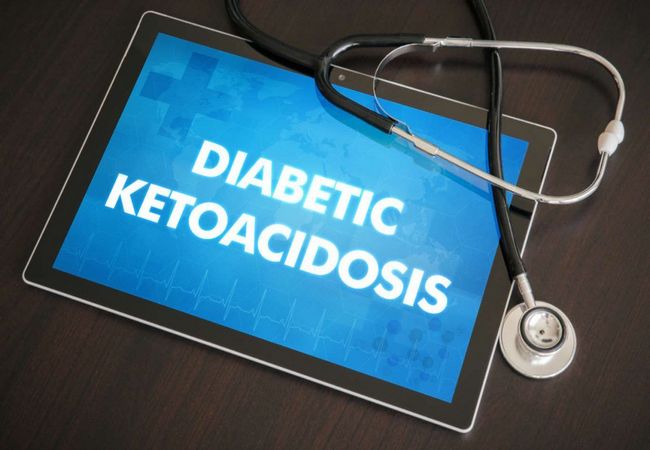Definition of Diabetic Ketoacidosis (DKA):
It is a serious complication of diabetes that occurs when body produces high levels of blood acids called ketones.

Causes of Diabetic Ketoacidosis (DKA):
An illness:
An infection or other illness can cause the body to produce higher levels of certain hormones, such as adrenaline or cortisol. Unfortunately, these hormones counter the effect of insulin sometimes triggering an episode of diabetic ketoacidosis. Pneumonia and urinary tract infections are common culprits.
A problem with insulin therapy:
Missed insulin treatments or inadequate insulin therapy can leave you with too little insulin in your system, triggering diabetic ketoacidosis.
Other possible causes of diabetic ketoacidosis include:
- Physical or emotional trauma,
- Heart attack,
- Alcohol or drug abuse, particularly cocaine,
- Certain medications, such as corticosteroids and some diuretics.
Management of Diabetic Ketoacidosis (DKA):
Symptoms of Diabetic Ketoacidosis (DKA):
- Polyuria, thirst
- Leg cramps
- Weight loss
- Blurred vision
- Weakness
- Abdominal pain
- Nausea,
- Vomiting.
Signs of Diabetic Ketoacidosis (DKA):
- Dehydration,
- Smell of acetone,
- Hypotension,
- Hypothermia (Postural or Supine),
- Confusion, drowsiness, coma (10%)
- Cold extremities/ peripheral cyanosis,
- Tachycardia,
- Air hunger (Kussmaul breathing).
Diagnosis of Diabetic Ketoacidosis (DKA):
History:
H/O diabetes.
History of precipitating factor:
- Inter-current infection
- Loss of appetite
- Either stop or reduce the dose of anti-diabetic drugs
- Any form of stress.
Investigation:
- Urinalysis: Ketonuria ( Rothares test)and (Benedict’s test)
- Blood glucose level: Very high.
- Blood urea & serum creatitine
- Serum electrolytes & bicarbonate
- Blood gases to assess the severity of acidosis
- Blood & urine CIS
- CBC- leukocytosis &CRP
- X Ray chest,
- ECG.
Treatment of Diabetic Ketoacidosis (DKA):
Principle components of Rx:
- Administration of short acting (soluble) insulin,
- Fluid replacement,
- Potassium replacement,
- Administration of antibiotics if infections are present.
Fluid replacement:
- 9% saline (NaCI) i.v.
- 1 litre over 30 minutes,
- 1 litre over 1 hr,
- 1 litre over 2 hrs,
- 1 litre over next 2-4 hrs.
When blood glucose < 15 mmol/I (270 mg/dl):
- Switch to 5% dextrose, 1 litre 8-hourly,
- If still dehydrated, continue 0.9% saline and add,
- 5% dextrosel litre per 12 hrs.
Typical requirement is 6 litres in first 24 hrs but avoid fluid overload in elderly patients.
Subsequent fluid requirement should be based on clinical response including urine output.
Insulin:
- 50 units soluble insulin in 50 ml 0.9% saline i.v. via infusion pump
- 6 units/hr initially
- 3 units/hr when blood glucose < 15 mmol/l (270 mg/dl)
- 2 units/hr if blood glucose declines < 10 mmol/1 (180 mg/dl)
- Check blood glucose hourly initially if no reduction in first hour, rate of insulin infusion should be increased
- Aim for fall in blood glucose of 3-6 mmol/I (55-110 mg/dl) per hour.
Alternatively:
- If IV infusion is not possible:
- 10 – 20 units soluble insulin IM stat then 4-6 units hourly.
- If no response within 2 hrs. the dose of insulin should be doubled.
- If blood glucose 10-15 mmol /L, insulin 1-4 units hourly.
Potassium:
- None in first litre of i.v fluid unless<3.0 mmol/I
- If plasma potassium<3.5 mmol/1, give 20 mmol/hr added potassium
- If plasma potassium is 3.5-5.0 mmnol/1, give 10 mmol /hr
Antibiotic:
Broad spectrum antibiotic if infection is present.
Additional measures in Mx of Diabetic Ketoacidosis (DKA):
- Catheterisation if no urine passed after 3 hrs.
- Nasogastric tube to keep stomach empty in unconscious or semiconscious patients, or if vomiting is protracted.
- Central venous line if cardiovascular system compromised, to allow fluid replacement to be adjusted accurately.
- Plasma expander if systolic BP is <90 mmHg or does not rise with i.v. saline.
- Antibiotic: Broad spectrum antibiotic if infection is present.
- ECG monitoring in severe cases.
Monitoring:
- Blood glucose & electrolyte hourly for 3 hrs & every 2 – 4 hrs thereafter.
- Temp, pulse, respiration, BP hourly.
- Urine output & ketones.
- ECG, plasma osmolality.
- Arterial PH in some cases.

Maria Khatun Mona is a Founder and Editor of Nursing Exercise Blog. She is a Nursing and Midwifery Expert. Currently she is working as a Registered Nurse at Evercare Hospital, Dhaka, Bangladesh. She has great passion in writing different articles on Nursing and Midwifery. Mail her at “maria.mona023@gmail.com”
